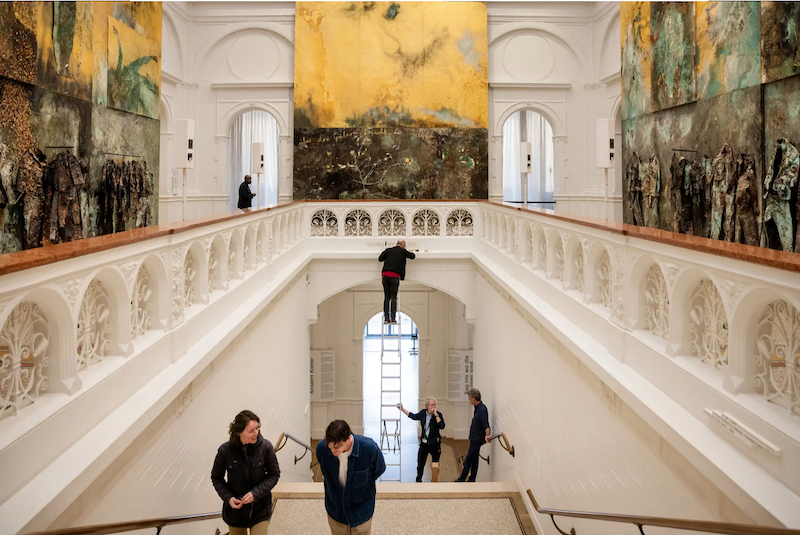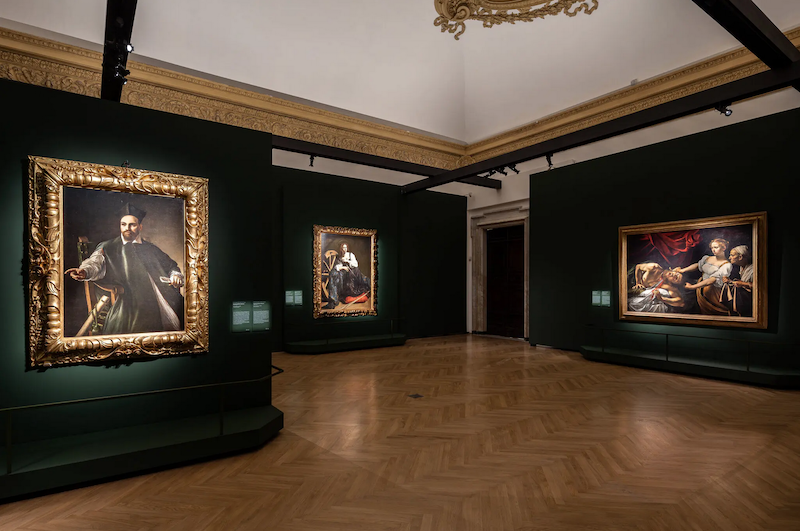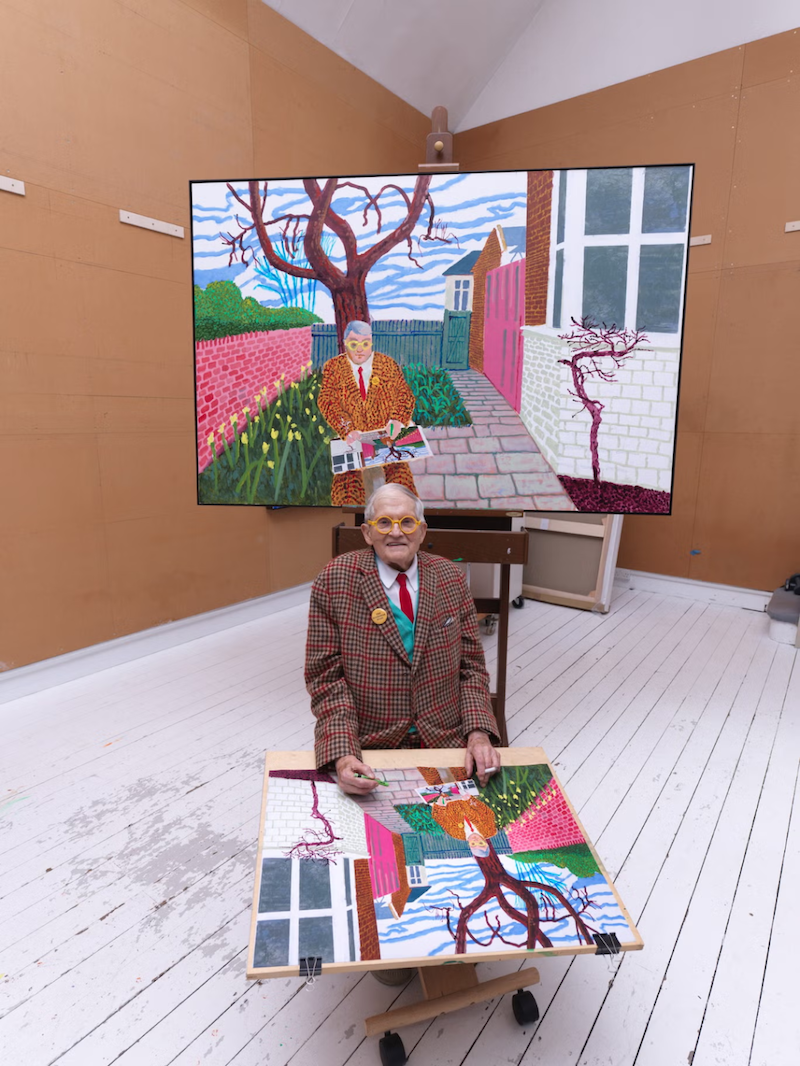
Anselm Kiefer is one of the representatives of German neo-expressionism and one of the most important artists of our time. His works use materials such as straw, ash, clay, and lead, and the themes are historical and poetic. Since childhood, Kiefer has admired Van Gogh, which is also reflected in his works.
Recently, Kiefer's solo exhibition "Where Have All the Flowers Gone" was on display at the Stedelijk Museum and the Van Gogh Museum in Amsterdam, the Netherlands. The Stedelijk Museum presented Kiefer's works and his latest creations in its collection, while the Van Gogh Museum exhibited Van Gogh's masterpieces and Kiefer's landscape paintings in response to Van Gogh. However, the huge paintings of this contemporary artist did not overshadow the starlight of Van Gogh's works. The colors that burst out from Van Gogh's heart expressed himself, while Kiefer's works were artworks produced on an industrial scale, an endless pile of materials, and lost the sincerity of his youth.
Anselm Kiefer’s new installation looms over the grand staircase of the Stedelijk Museum Amsterdam. Paintings in oxidized copper and gold leaf stretch from floor to ceiling, and military uniforms hanging within sight are splattered with paint and rendered rigid. Dried petals tumble off the canvas onto the floor. In a young self-portrait, Kiefer is at the bottom of a panel with a tree growing out of his chest.

Kiefer's works on the grand staircase of the Stedelijk Museum in Amsterdam
The installation is the theme of a large solo exhibition by Kiefer, which includes 25 paintings, 13 drawings and three videos created by Kiefer from 1973 to the present, as well as eight works by Van Gogh. The exhibition theme "Sag mir wo die Blumen sind" (German), also known as "Where Have All the Flowers Gone?", spans the Stedelijk Museum and the Van Gogh Museum in the Netherlands.
The exhibition, which opened the day before Kiefer’s 80th birthday, is a collaboration between the Van Gogh Museum and the Stedelijk Museum in Amsterdam. The sheer scale of Kiefer’s work made sense from a physical standpoint, as each of his works takes up a wall or a room.

Kiefer
Curator Edwin Becker said what links the two parts of this "diptych" is Kiefer's anti-war sentiment, expressed in both subtle and overt ways. The title and new work at the heart of Amsterdam's Stedelijk Museum refer to the 1955 Pete Seeger folk song "Where Have All the Flowers Gone?" However, Kiefer used the lyrics from a German version popularized by Marlene Dietrich in the early 1960s.
Kiefer said in an interview with the media: "The most important line in the song is 'When will we learn'. The rest of the song is a bit cheesy, but this line has a deeper meaning. We don't know why things keep happening again and again. Our current situation is like Germany in 1933. It's terrible."

Kiefer's work at the exhibition, showing a military uniform sprayed with paint

Exhibition site
Born in Donaueschingen, Germany, at the end of World War II, Kiefer has long grappled with the legacy of fascism, political violence and cultural memory. “War is a theme that runs through his entire work,” said Leontine Coelewij, curator of contemporary art at the Stedelijk Museum in Amsterdam, who curated the exhibition. “His first works already dealt with World War II. Since then, the theme has appeared in many different forms.”
In 1969, when Kiefer was a 24-year-old art student, he traveled across Europe, posing in front of historical sites for the performance work Occupations. He wore a hippie robe and a business suit, with his arm outstretched in a Nazi salute. "Heroic Symbols was a series of photos he took," said Klevy. "It was a provocation to those Germans who didn't want to talk about the war." At the time, such subjects were taboo in Germany. The young Kiefer felt exiled from his homeland in terms of his artistic creation.

Kiefer's large-scale works
The first work in the exhibition is Kiefer's 1981 painting "Innerraum" (Interior), a view of the Skylight Room in the Chancellery in Berlin, where Hitler met with members of his army in this dilapidated, empty room to make plans to destroy and seize Europe. "Kiefer's work is very much about politics, but not specifically politics," said Kollerwe. "We can all think of situations in the world where we can see the absurdity of war and ask: Why does it still happen?"
This project, of course, did not originate from an anti-war exhibition, but was conceived by Emilie Gordenker shortly after she became director of the Van Gogh Museum in 2020. The previous year, Kiefer gave a lecture at London’s Tate Britain about his relationship with Van Gogh, and subsequently created a series of large-scale landscapes inspired by Van Gogh’s work.

Dried petals fall to the floor in one of Kiefer's works
Kiefer said that Van Gogh's influence on him began when he was 13 years old. In 1963, the 18-year-old Kiefer received a travel scholarship and traveled around Europe following Van Gogh's footsteps, starting from Zundert, the Netherlands, where Van Gogh was born, passing through Belgium and Paris, and finally hitchhiking to the south of France. He stayed in Fulkes near Arles for several months because Van Gogh painted his most famous work, the "Sunflowers" series, there.
The Van Gogh Museum juxtaposes his paintings with Kiefer’s monumental landscapes, which are nearly 30 feet wide, including Die Krähen (The Crows), 2019, and De sterrennacht (The Starry Night), 2024, which is made of bales of hay. Also on display are Van Gogh’s Wheat Field With Crows (1890) and Sunflowers Gone to Seed (1890), which are much smaller in size but no less impactful.

Kiefer's self-portrait as a young man, showing him lying at the bottom of a drawing board with a tree growing out of his chest
Becker, the exhibition director of the Van Gogh Museum, said, "Kiefer's landscapes also 'carry the burden of history.' He applied layer after layer of muddy paint on the canvas, oil paint and acrylic paint mixed with raw materials such as soil, iron, straw and dead leaves, forming deep gullies on the canvas. These landscapes with Van Gogh-style high horizons seem to be ruins pierced by blood and shrapnel.
Kiefer said his work is not intended to depict politics or any specific world events, but he keeps an eye on current events. He feels personally threatened by the recent rise of right-wing authoritarian leaders in Germany and the United States. At 80, Kiefer doesn't seem to be slowing down or backing down. "When I paint, I don't use my mind, I use my body," he said. He said he knew too much about the war, so he brought it to the canvas. "It's not to warn people, but I hope it is a warning."

Kiefer, The Unconquerable Sun, 1995
But the juxtaposition of Kiefer’s work with Van Gogh’s is a fatal decision. Kiefer is a creative giant in the art world today, but when his work hits Van Gogh’s wheat field here, it becomes a smoking ruin. Kiefer may want people to see him differently. He is a sensitive natural painter, Van Gogh is his kindred spirit, and just as the Dutch fled to Arles, Kiefer has a home and studio in the south of France. But he can’t be small and exquisite. One of his huge paintings looks like a Stuka bomber dive-bombing the town of Auvers-sur-Oise. Another huge painting recreates Van Gogh’s "Starry Night" with a huge swirl of straw. There is darkness, madness and loneliness in Van Gogh, but all of this is restrained by his humble mission to observe the world. Kiefer replaces Van Gogh’s small paintings with huge scale, replaces trust in paint with a pile of dead things, and replaces substance with feeling.

Kiefer's "Lime Tree Under the Heather" and Van Gogh's "Wheat Field with Skylarks" exhibited in the Van Gogh Museum

Kiefer, Starry Night, 2019
Will the huge paintings of the 21st century overwhelm the small paintings of the 19th century? No. You will be deeply attracted by the works of Van Gogh. Van Gogh is here, expressing his reaction with colors bursting from his heart. From "Crows over the Wheat Field" to Kiefer's huge paintings, it is like going from a sincere folk song to a vulgar musical. Van Gogh, he is perhaps the most real of all artists. And Kiefer? He seems unreal, he is endlessly adding materials.

Van Gogh: Crows over a Wheat Field

Kiefer, The Raven, 2019
In the Stedelijk Museum in Amsterdam, you can see Kiefer’s response to Van Gogh’s Wheatfield with a Reaper: he fixed a real sickle to it. Nearby, you can see the film he shot at his estate in Barjac. He built a new road, a tunnel between the main house and the “children’s house”, and a war landscape of concrete bunkers in this sunny French land. Van Gogh was a pauper who barely survived on charity from his brother. Kiefer belongs to the world of commercial art, in which successful artists live in huge estates overlooked by helicopters and produce art on an industrial scale.

Kiefer Sketch

Kiefer Sketch
In early footage, Kiefer, a handsome, focused teenager, receives a grant to visit Van Gogh’s landscapes in the Netherlands and France, showing drawings he made as a young man and his loving imitations of Van Gogh.
Sadly, Kiefer’s later responses to Van Gogh seem more artificial than his youthful sincerity. As the exhibition title suggests, “Where Have All the Flowers Gone?” Indeed, it is.
The exhibition will run until June 9th.
(This article is translated from The New York Times, The Guardian, and the official websites of the Van Gogh Museum and the Stedelijk Museum in Amsterdam)


